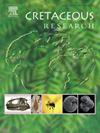New species of Lechytia Balzan, 1892 (Arachnida: Pseudoscorpiones) from Burmese amber highlights 99 million years of morphological stasis
IF 1.7
3区 地球科学
Q1 GEOLOGY
引用次数: 0
Abstract
The pseudoscorpion genus Lechytia Balzan, 1892 (Chthoniidae Daday, 1889: Lechytiinae Chamberlin, 1929) includes 27 extant species that are distributed across all continents except Antarctica, and a single extinct species from Dominican amber of Miocene age. We document the first record of Lechytia from Burmese amber (Cenomanian: ∼99 Ma), Lechytia finniae sp. nov., making it the oldest fossil record for Lechytia and extending the known temporal range of this group by more than 70 million years into the Mesozoic. The new species differs from most extant Lechytia species due to the distance between trichobothria sb and b that are separated by at least one areolar diameter, and by the absence of eyes. Since there is a close morphological resemblance between L. finniae sp. nov. and extant Lechytia species, the new fossil is placed in an extant genus and represents yet another example of morphological stasis in pseudoscorpions. The presence of Lechytia in Burmese amber implies that this genus was present on the Burma Terrane in the Cretaceous although no extant species are known from this landmass today. The ecology of extant species may lend support to a tropical forest environment on the Burma Terrane.
缅甸琥珀中的 Lechytia Balzan, 1892(蛛形纲:伪蝎属)新种凸显了 9,900 万年的形态停滞期
假蝎子属Lechytia Balzan, 1892 (Chthoniidae Daday, 1889; Lechytiinae Chamberlin, 1929)包括27个现存物种,分布在除南极洲以外的所有大陆,以及一个在新世多米尼加琥珀中灭绝的物种。我们在缅甸琥珀(Cenomanian: ~ 99 Ma)中首次记录了Lechytia finniae sp. nov.,使其成为最古老的Lechytia化石记录,并将该类群的已知时间范围延长了7000多万年至中生代。新物种不同于大多数现存的蛭形虫,因为蛭形虫sb和b之间的距离至少相隔一个乳晕直径,而且没有眼睛。由于L. finniae sp. 11 .与现存的Lechytia物种有着密切的形态相似性,新化石被放置在一个现存的属中,代表了假蝎子形态停滞的另一个例子。在缅甸琥珀中发现的lehytia表明,该属在白垩纪时就存在于缅甸大地上,尽管目前在这片大陆上没有已知的现存物种。现存物种的生态可以支持缅甸地面上的热带森林环境。
本文章由计算机程序翻译,如有差异,请以英文原文为准。
求助全文
约1分钟内获得全文
求助全文
来源期刊

Cretaceous Research
地学-地质学
CiteScore
4.10
自引率
19.00%
发文量
235
审稿时长
12 weeks
期刊介绍:
Cretaceous Research provides a forum for the rapid publication of research on all aspects of the Cretaceous Period, including its boundaries with the Jurassic and Palaeogene. Authoritative papers reporting detailed investigations of Cretaceous stratigraphy and palaeontology, studies of regional geology, and reviews of recently published books are complemented by short communications of significant new findings.
Papers submitted to Cretaceous Research should place the research in a broad context, with emphasis placed towards our better understanding of the Cretaceous, that are therefore of interest to the diverse, international readership of the journal. Full length papers that focus solely on a local theme or area will not be accepted for publication; authors of short communications are encouraged to discuss how their findings are of relevance to the Cretaceous on a broad scale.
Research Areas include:
• Regional geology
• Stratigraphy and palaeontology
• Palaeobiology
• Palaeobiogeography
• Palaeoceanography
• Palaeoclimatology
• Evolutionary Palaeoecology
• Geochronology
• Global events.
 求助内容:
求助内容: 应助结果提醒方式:
应助结果提醒方式:


